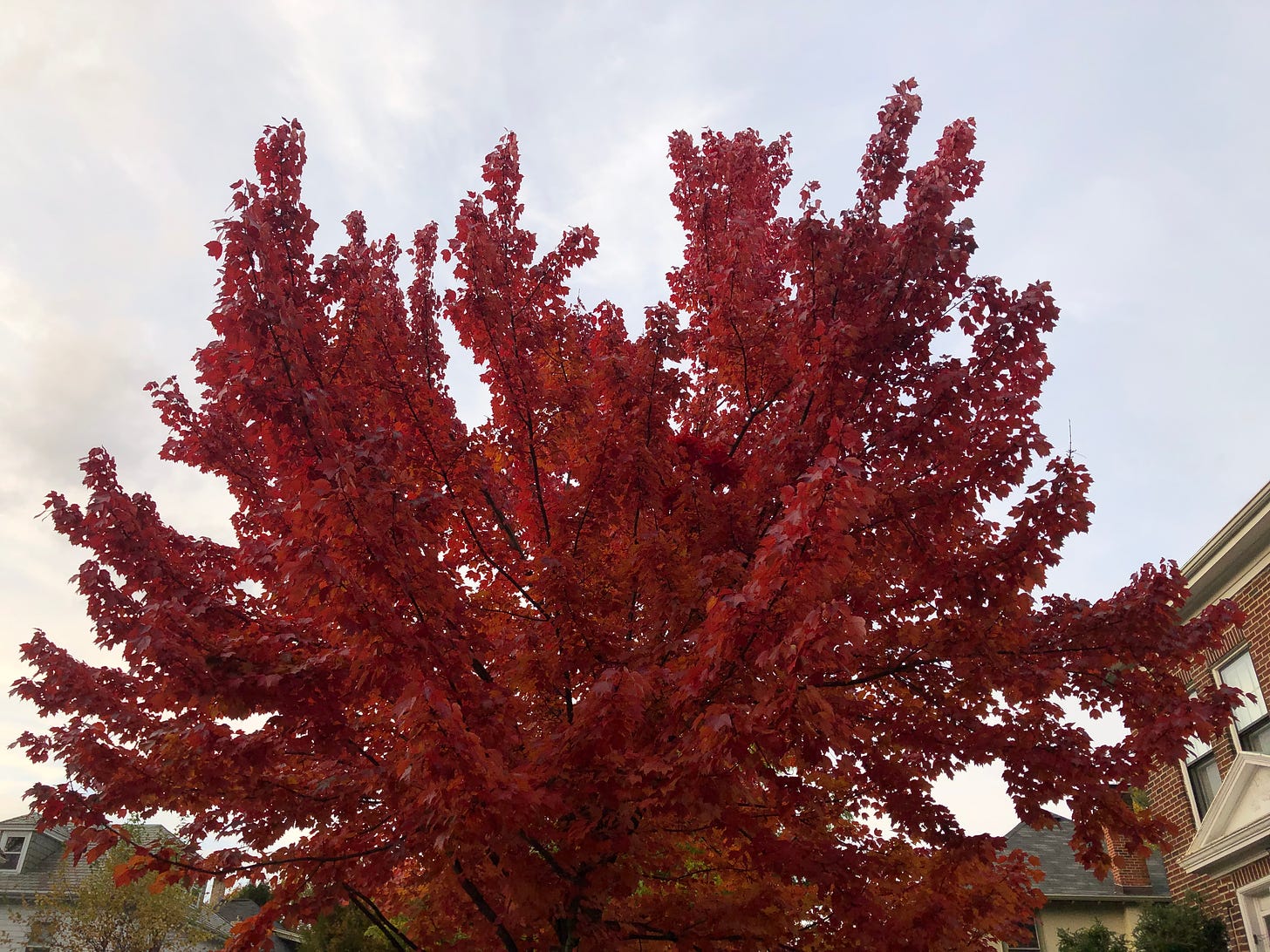It is a perfect autumn afternoon: comfortably warm in the sun, crisply cool in the shade. The aroma of leaves wafts upward from the carpet crumbled on the ground. I am on a walk with part of my immediate family— at least with those of us who live locally. My dad guides the stroller across the patchy pavement, and then pushes the cover back so my four-month-old niece can enjoy the afternoon sunlight and see the world. She is already having a good day: cooing, laughing, interacting with us as we obsessively peer down at her. But as the cover folds back, as her vision widens past our faces, she beams with an even deeper delight. Her gaze is no longer simply at us, but it darts up and away, far beyond us, as if “to gaze upon the beauty of the Lord.”1
I watch her drinking the world in. She is filled to the brim with joy, relishing the leaves glowing in golden-hour light, and the dark branches silhouetted against the blue expanse. Every day is a precious collection of firsts for her; she is elated by every thing she sees. There is no pretense, no performance, no self-consciousness in her innocent enjoyment. Her behavior is not immature or unwarranted but pure, honest, even wise. I am reminded of Jesus saying: “I thank you, Father, Lord of heaven and earth, that you have hidden these things from the wise and understanding and revealed them to little children.”2
There is something out there that is accessible to her, that she can see. There is something that she has not yet lost that allows her to delight and to rest openly without fear, without understanding. I’m struck by how sight like hers, so childlike and trusting, seems illusive and complicated to me. Maybe my 30+ years have made me foolish. Maybe I need to shed some leaves like the trees so that I too can enter into spring and become young again.
In my career as a nurse one of my niche interests is wound care. Gross, I know, but I’ll spare you the details. It is a field that rests heavily upon the gaze, on the ability to see a mess clearly, to make an astute assessment of the whole thing, and to take creative action in moving the slow process of healing forward, day-by-day. Helplessness is the common denominator for patients who require this kind of care. Entering into this realm of need requires courage for the caregiver who is seeing the wound, but more so for the person whose wounds are being seen. It is humbling and humiliating for vulnerable parts of the body to be exposed to such specialized and invasive attention. Yet in this arena, the willingness to rest under the caregivers compassionate gaze is the gateway into healing. And so it is in our life with Christ.
“Before [Jesus’] gaze all falsehood melts away. This encounter with him, as it burns us, transforms and frees us, allowing us to become truly ourselves… His gaze, the touch of his heart heals us through an undeniably painful transformation ‘as through fire.’ But it is a blessed pain, in which the holy power of his love sears through us like a flame, enabling us to become totally ourselves and totally of God.” — Pope Benedict
The story of Hagar comes to mind, a woman who lived a life of invisibility as a foreign female slave in the house of the patriarch Abraham, and who experienced a variety of abuses at the hands of her employers. Yet in spite of the poverty of her social station, she found herself the honored recipient of a divine encounter in the wilderness. Her simple response speaks volumes: “You are the God who sees me.”3 No pagan god would ever show up for an outcast, a foreigner, or a (female) slave. They would never appear in the dessert, far away from the sight of those who seemed to matter most— she knew this to her core. But this God was not interest in proving anything to anyone but her. In suffering and obscurity she was a worthy recipient of the gaze of God. Whether she had felt it before or not, she had always been seen.
Just as Hagar experienced and as Pope Benedict wrote thousands of years later, becoming aware of the gift of his sight heals, purifies, and empowers. Sight is a two way street: we must see and we must be seen. It was Christ who saw children, saying that the greatness of the kingdom of heaven was to be found in their innocence and need.4 It was Christ who saw the broken, looking tenderly upon their wounds with a hospitable lack of surprise. Wisdom is to be found in learning to see like a child, with delight like my niece, and it is to be found in learning to rest without fear in being seen by God, as one who is dearly beloved. In that spacious place we find the true and the beautiful alongside the broken, and we can confidently offer it all back to him.
Psalm 27:4 ESV
Matthew 11:25 ESV
Genesis 16:13
Matthew 18:3-4 ESV




